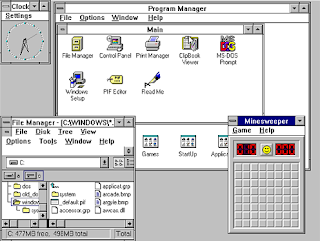Microsoft Windows has seen nine noteworthy variants since its first discharge in 1985. More than 29 years after the fact, Windows looks altogether different yet by one means or another acquainted with components that have survived the test of time, increments in registering force and – most as of late – a movement from the console and mouse to the touchscreen.
Here's a brief take a gander at the historical backdrop of Windows, from its introduction to the world because of Bill Doors with Windows 1 to the most recent landing under new Microsoft CEO Satya Nadella.
Window1
This is the place it began for Windows. The first Windows 1 was discharged in November 1985 and was Microsoft's first genuine endeavor at a graphical client interface in 16-bit.
Advancement was initiated by Microsoft author Bill Doors and kept running on top of MS-DOS, which depended on order line data.
It was prominent on the grounds that it depended vigorously on utilization of a mouse before the mouse was a typical PC data gadget. To offer clients some assistance with becoming acquainted with this odd information framework, Microsoft incorporated a diversion, Reversi (noticeable in the screenshot) that depended on mouse control, not the console, to get individuals used to moving the mouse around and clicking onscreen components.
Window2
Two years after the arrival of Windows 1, Microsoft's Windows 2 supplanted it in December 1987. The huge development for Windows 2 was that windows could cover one another, and it likewise acquainted the capacity with minimize or amplify windows as opposed to "iconising" or "zooming".
The control board, where different framework settings and arrangement alternatives were gathered together in one spot, was presented in Windows 2 and gets by right up 'til today.
Microsoft Word and Exceed expectations additionally showed up running on Windows 2.
Windows 3
The primary Windows that required a hard drive propelled in 1990. Windows 3 was the first form to see more across the board achievement and be viewed as a challenger to's Mac and the Commodore Amiga graphical client interfaces, coming pre-introduced on PCs from PC-perfect producers including Pinnacle Information Frameworks.
Windows 3 acquainted the capacity with run MS-DOS programs in windows, which conveyed multitasking to legacy programs, and upheld 256 hues bringing a more advanced, beautiful look to the interface.
More vital - at any rate to the aggregate of human time squandered - it presented the card-moving timesink (and mouse use coach) Solitaire.
Windows 3.1
Windows 1 and 2 both had point discharge upgrades, however Windows 3.1 discharged in 1992 is prominent on the grounds that it presented TrueType text styles making Windows a practical distributed stage interestingly.
Minesweeper likewise showed up. Windows 3.1 required 1MB of RAM to run and permitted upheld MS-DOS projects to be controlled with a mouse surprisingly. Windows 3.1 was additionally the first Windows to be dispersed on a Compact disc ROM, albeit once introduced on a hard drive it just took up 10 to 15MB (an Album can normally accumulate to 700MB).
Windows 95
As the name infers, Windows 95 touched base in August 1995 and with it brought the first ever Begin catch and Begin menu (propelled with a monstrous publicizing effort that utilized the Rolling Stones' Begin Me Up, and two or after three months Companions stars Jennifer Aniston and Matthew Perry. Would it be able to be any more up and coming?)
It likewise presented the idea of "fitting and play" – interface a fringe and the working framework discovers the proper drivers for it and makes it work. That was the way to go; it didn't generally work practically speaking.
Windows 95 likewise presented a 32-bit environment, the errand bar and concentrated on multitasking. MS-DOS still assumed an essential part for Windows 95, which obliged it to run a few projects and components.
Web Pilgrim likewise made its introduction on Windows 95, yet was not introduced as a matter of course requiring the Windows 95 Or more! pack. Later corrections of Windows 95 included IE as a matter of course, as Netscape Pilot and NCSA Mosaic were prominent at the time.
Windows 98
Discharged in June 1998, Windows 98 based on Windows 95 and carried with it IE 4, Viewpoint Express, Windows Location Book, Microsoft Talk and NetShow Player, which was supplanted by Windows Media Player 6.2 in Windows 98 Second Release in 1999.
Windows 98 presented the back and forward route catches and the location bar in Windows Voyager, in addition to other things. One of the greatest changes was the presentation of the Windows Driver Model for PC parts and adornments – one driver to bolster every future rendition of Windows.
USB backing was abundantly enhanced in Windows 98 and prompted its across the board selection, including USB center points and USB mice.
Windows Me
Considered a low point in the Windows arrangement by numerous – at any rate, until they saw Windows Vista – Windows Thousand years Version was the last Windows to be founded on MS-DOS, and the toward the end in the Windows 9x line.
Discharged in September 2000, it was the customer pointed working framework twined with Windows 2000 went for the undertaking business sector. It acquainted some critical ideas with customers, including more computerized framework recuperation instruments.
IE 5.5, Windows Media Player 7 and Windows Motion picture Creator all showed up interestingly. Autocomplete likewise showed up in Windows Wayfarer, however the working framework was famous for being carriage, neglecting to introduce appropriately and being for the most part poor.
Windows 2000
The undertaking twin of ME, Windows 2000 was discharged in February 2000 and depended on Microsoft's business-orientated framework Windows NT and later turned into the premise for Windows XP.
Microsoft's programmed redesigning assumed a critical part in Windows 2000 and turned into the first Windows to bolster hibernation.









EmoticonEmoticon